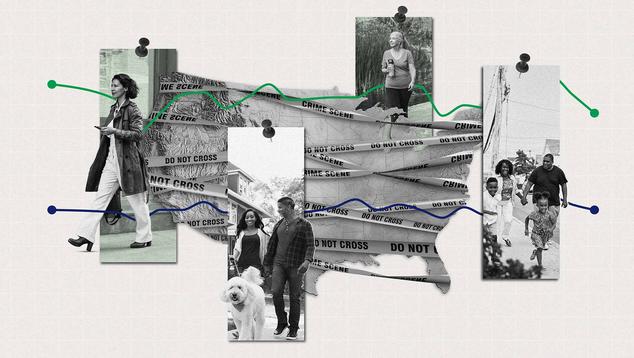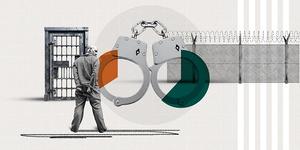Gallup’s recent updates on Americans’ perceptions of crime include many important insights, as my colleagues Megan Brenan and Lydia Saad have reviewed. One of these is an update on a significant social phenomenon: Americans are much more negative about crime in the U.S. nationally than when asked about crime in their local area. In an October poll, 49% of Americans said that the crime situation in the U.S. is extremely or very serious. But only 12% said the same about the local area where they live.
This Is Not a New Phenomenon
The local-national gap has been evident in every poll since Gallup’s crime series began in 2000. Americans’ views of the seriousness of crime nationwide over this 25-year period have averaged 43 percentage points higher than their views of local crime.
Scholars have spent significant time and effort examining this “local positivity bias.” It’s evident not only in reference to crime, but also in perceptions of education and schools, the economy, and healthcare. Americans also consistently rate their personal member of Congress much higher than they rate Congress as a whole, known in the political science literature as Fenno’s paradox.
Exploring Reasons for the Local-National Gap
An important study from Pew Research last year showed that Americans are most likely to get their information about local crime from friends, family, neighbors and local news outlets.
These local sources aren’t available at the national level. Most Americans have no general experience with crime “out there” across the country. They instead rely on information from media (mass or social).
This national news coverage can easily end up leaving the impression of higher (or, in some cases, lower) levels of crime than is actually the case. National media (traditional and social) often highlight violent, unusual or geographically dispersed crimes. These may be rare, for the most part. But they can add up in the public imagination as being constantly occurring. This, in turn, can lead to perceptions of a nation facing serious crime problems. (Local news also, of course, features crime as a routine staple of local news coverage. But Americans have their personal experiences as a check against what the local media portray.)
Additionally, today’s news environment increasingly includes news sites and social media that cater to particular niche audiences. These sources can often amplify or downplay the seriousness of crime in order to promote desired narratives and policies. These frames, in turn, could shape national evaluations, even if not factually accurate.
Bottom line: When asked about local crime, people can rely on direct experiences, which anchor their judgments. National perceptions are anchored in dramatic events and broader narratives.
National Perceptions of Crime Logically Less Accurate Than Local Perceptions
We may assume that people’s perceptions of crime locally are more closely tied to reality than their perceptions of crime nationally. But the “reality” of crime statistics isn’t always easy to determine. As I reviewed several years ago, “Precise estimates of trends in the actual incidence of crime (‘in the real world’) are more difficult to ascertain than might be thought.” Even government crime statistics have problems. There are a number of sources of crime statistics that vary in frequency and quality, and at times they contradict one another.
Studies that do attempt to map perceptions to measured crime rates often show a gap between public opinion and actual crime at the national level. As one Federal Reserve study concluded: “In the United States, crime rates have been falling sharply since their peak in the 1990s. … Despite the overall long-term declining trend, people's perceptions of crime have been shifting, according to various polls, in the opposite direction.”
Gallup’s recent crime survey has some interesting data that speak to the issue of how the public perceives crime. In the poll, 65% of Republicans and Republican-leaning independents say crime at the national level is extremely or very serious. That compares to 37% of Democrats and Democratic-leaning independents. But there have been times when Democrats were just as likely as or more likely than Republicans to say national crime is serious. Republicans tend to rate national crime as more serious than Democrats with a Democrat in the White House. This pattern is reversed when a Republican is in office. Democrats rated crime higher than Republicans during George W. Bush’s presidency, and roughly as high as or higher than Republicans during Donald Trump’s first term. (Of note, in our recent update, Republicans’ views of crime have stayed high.)
Key point: Actual crime rates don’t flip on a dime when a new president takes office. Shifting views of crime at the national level are, thus, not based solely on real-world changes in crime. They reflect a subjective halo based on the party of the presidential administration. They also reflect variations in belief that a particular president is going to be able to effectively (or ineffectively) address crime.
Importantly, the partisan gap disappears when Americans are asked about local crime. Both groups (11% of Republicans and 9% of Democrats) are very unlikely to say local crime is serious. There is also little difference in the partisan groups’ views of local crime over time. We assume that with local, experiential data available, the subjective factors seen at the national level tend to be less important.
Gallup also tracks a question asking Americans whether crime in the U.S. is increasing or decreasing. In all but three of 32 measures taken since 1989, majorities (often, significant majorities) of Americans have said that crime nationally is increasing. This clearly does not fit with available crime data. Particularly in recent decades, most official sources show that crime has been decreasing.
Perceptions at the national level, in short, reflect subjective as well as objective reality. That subjective reality can include a way that Americans express their dissatisfaction with crime in general, regardless of its relative increase or decrease in prevalence.
Bottom line: When it comes to perceptions of local crime, reality sets in. When it comes to perceptions of national crime, much less so. The results of questions about national crime are more subjective and provide other types of information.
Even If National Perceptions of Crime Are Less Accurate, They Have Real Value and Real Consequences
Americans’ perceptions carry with them their own reality. They are real to the individual. And have real implications. As social psychologist W.I. Thomas famously wrote (with Dorothy Swaine Thomas) in 1928, “If men define situations as real, they are real in their consequences.”
Thomas’ conclusion is, in my estimation, a very valuable contribution of social science. And a key reason why public opinion polling is so important. Regardless of reality, people’s views determine how they see and act relating to the world around them. Thus, regardless of the underlying reality, Americans’ perceptions of the seriousness of crime, particularly at the national level, can influence policy preferences and public discourse, making them “real in their consequences.”
Thus, surveys measuring perceptions of national crime have real value. They are a vital measure of social reality. Survey questions measure the mental and emotional climate of the country, even when detached from objective indicators. The perceptions become the lens through which citizens and leaders act.
Americans’ perceptions of crime at the national level help shape political agendas and policy priorities. Even when people feel safe where they live, their belief that the nation as a whole is unsafe can drive national political behavior. Or it may be that if people feel unsafe at home, their belief that the nation as a whole is unsafe is a way of expressing their concern. Whatever the case, national crime perceptions can drive national politics. Policy can follow narratives rather than reality.
Bottom Line
The local-national crime perception gap is important for several reasons.
Americans’ perceptions of crime can provide valuable insights into what is happening in their environment. Crime statistics are not always available or reliable. Americans’ perceptual measures can be viewed as important input derived from a thousand or so informants scattered out there across the country.
Also, the view that crime is less serious where people live can be seen as a fundamentally positive message. It tells us that people have trust in their communities and that their neighborhoods, police and local institutions are functioning well enough to protect them.
At the national level, even if not directly related to available crime data, the public’s routine and continuing insistence that crime is more serious than local crime may be signaling concern for the broader society, which can be viewed as a kind of civic empathy and civic awareness.
While Gallup’s national data paint a negative picture, the contrast with local data can remind us that “crime” is not a single entity. Showing that most Americans feel safe locally can bring balance and promote more evidence-based policymaking.
Most importantly, whatever the reality, Americans’ perceptions of crime can have real effects and real consequences. These consequences include voting, support for specific policies, and overall feelings of anxiety or pessimism. It is critically important to measure what Americans are thinking and feeling about crime because those thoughts are ultimately going to drive real-world actions.
Finally, the local-national gap reminds us that factual information matters. If Americans’ views of crime at the national level are out of sync with trends in reliable official data, it suggests we need to improve the way in which Americans get their information. Society, we can assume, functions better if the people, ultimately in control in a democracy, have the best and most accurate information possible about what is happening around them and around the nation.
Stay up to date with the latest insights by following @Gallup on X and on Instagram.




